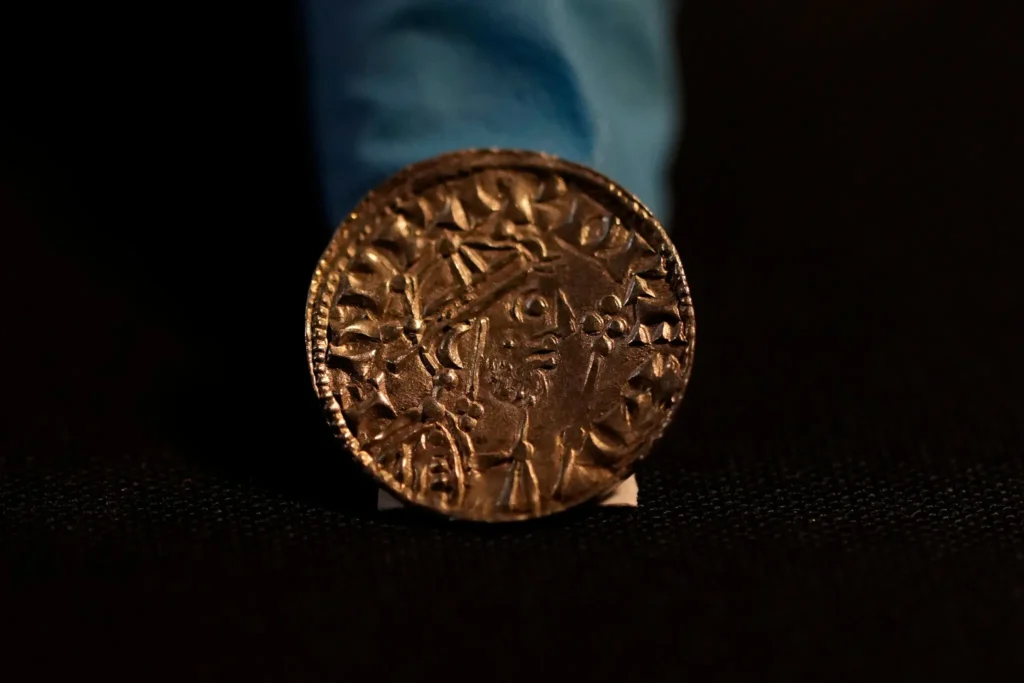In a quiet field in Somerset, England, a group of seven friends testing a metal detector discovered a hidden piece of British history—a hoard of silver coins that lay buried for nearly a thousand years. Known now as the Chew Valley Hoard, this cache of 2,584 coins, dating back to the turbulent period following the Norman Conquest of 1066, is valued at $5.6 million (£4.3 million). This find not only captivated historians but also became the largest Norman-era coin hoard ever discovered in Britain.
A Remarkable Discovery in Somerset’s Fields
It was an ordinary day in 2019 when Adam Staples and six friends took their metal detectors to a farmer’s field in Somerset. For Staples, a long-time detectorist, metal-detecting was a familiar hobby, but none could have anticipated the treasure they were about to uncover.
“I was jibbering on about the Battle of Hastings,” Staples joked, as he and his friends unearthed one coin after another, each one seeming to deepen the mystery. The coins were minted between 1066 and 1068, showing images of both King Harold II and his successor, William the Conqueror.
As the group gathered around their growing pile of silver coins, it became clear that they had stumbled onto something extraordinary. “We thought, maybe five or ten coins,” Staples recalled, “but it just got bigger and bigger.” The find became one of the most valuable and historically significant discoveries in British metal-detecting history.
The History Behind the Hoard: The Norman Conquest

The Chew Valley Hoard offers a tangible connection to one of Britain’s most pivotal moments: the Norman Conquest. The Battle of Hastings in 1066 marked the end of Anglo-Saxon rule and ushered in a new era of Norman monarchy led by William I. The coins in the hoard represent this transition, with about half depicting the defeated Harold II and the other half showing William, the new king.
Michael Lewis, head of the Portable Antiquities Scheme at the British Museum, remarked on the hoard’s potential to deepen public understanding of this iconic historical period. “It’s a story based on certain myths,” Lewis noted, highlighting how the hoard challenges simple narratives about “good” Saxons versus “bad” Normans.
Safeguarding Treasure: Britain’s Treasure Act
Once the hoard was uncovered, Staples and his friends immediately informed a local coroner under Britain’s 1996 Treasure Act, which mandates that any precious metal object older than 300 years must be reported. The Act ensures that significant finds are preserved for public benefit, allowing museums to bid for acquisition while rewarding the finders and landowners with a portion of the treasure’s market value.
This lengthy process led to the hoard’s acquisition by the South West Heritage Trust with the help of a £4,420,527 grant from the National Lottery Heritage Fund and additional funds from the Art Fund. These grants allowed the hoard to remain in the country, ultimately finding a permanent home at the Museum of Somerset.
A Hoard of National Significance

Experts believe the hoard was buried during the years of rebellion that followed William’s conquest, perhaps for safekeeping. With Anglo-Saxon forces mounting attacks against the Normans, it’s likely that someone buried the coins to protect them from looting. “We know that the people of Exeter rebelled against William in 1068,” said Amal Khreisheh, curator of archaeology at the South West Heritage Trust, “and Harold’s sons, exiled in Ireland, were mounting attacks.”
Unlike previous discoveries, the Chew Valley Hoard contained nearly five times the number of first-type coins of William I ever found, giving historians an invaluable resource for studying the period’s economy, coinage, and societal shifts.
A Life-Changing Find and What It Means for Britain
For Adam Staples and his friends, the treasure meant more than a massive financial windfall. The value, divided between the seven detectorists and the landowner, changed their lives, with Staples reportedly using his share to buy a home. But for Staples, the joy of the discovery goes beyond the monetary reward. “It’s like winning the lottery,” he said, “but I’m not going to give up now. I love it.”
Preserving Britain’s Heritage
The Chew Valley Hoard stands as a testament to the importance of preserving national heritage. Once its initial exhibition at the British Museum concludes, it will return to Somerset, where it will join the Museum of Somerset’s collection, allowing the public to view this significant piece of British history. The find not only sheds light on a turbulent chapter in English history but also celebrates the dedication of hobbyists who adhere to the Treasure Act, safeguarding Britain’s historical legacy for future generations.

